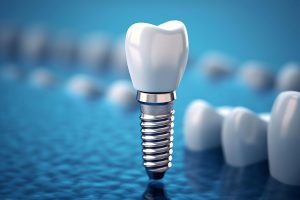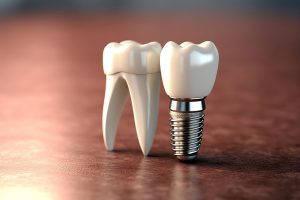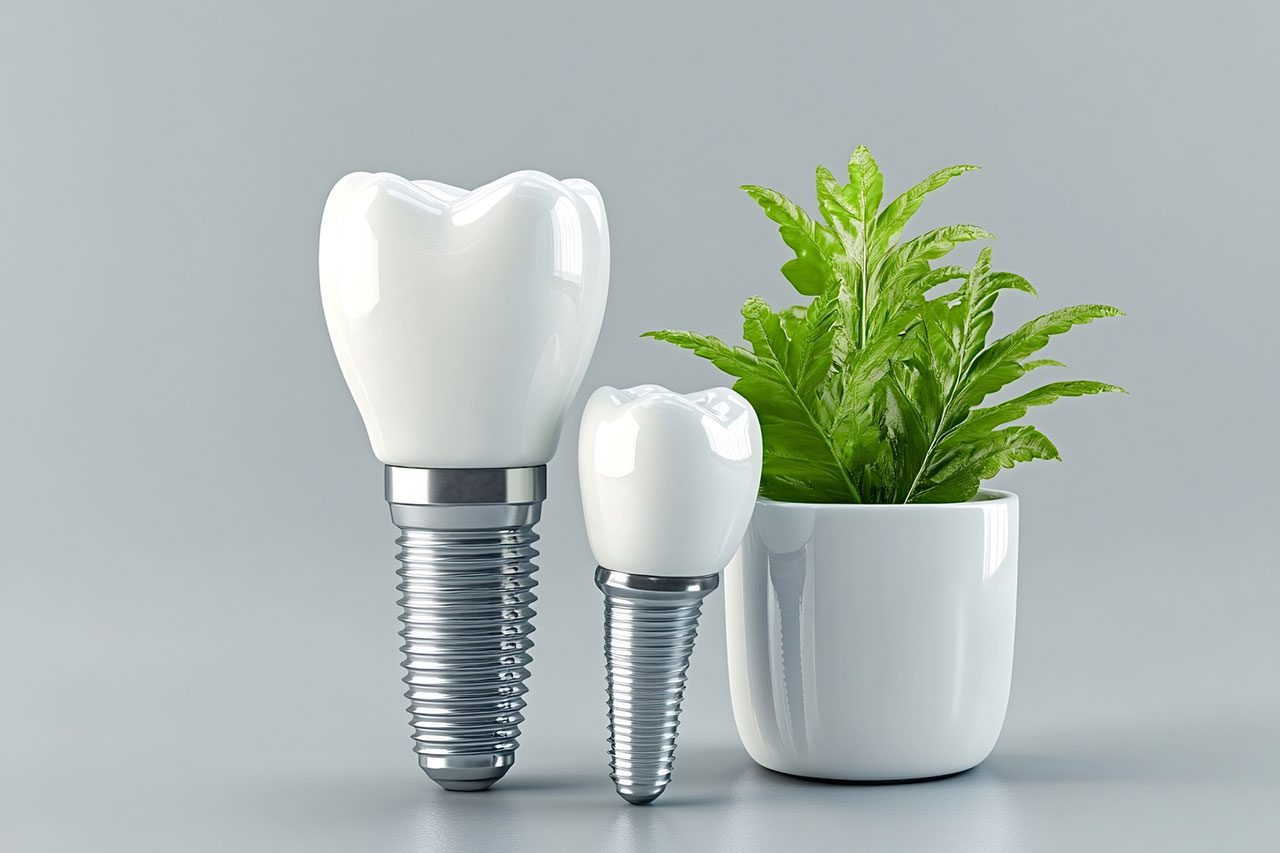Life-cycle assessments indicate that manufacturing a single titanium implant can emit up to 85 kg of carbon-dioxide equivalents, largely because of the high-temperature atomisation of powder that precedes milling and machining. Recent clinical series show that zirconia implants – formed from a bio-inert ceramic rather than metal – achieve five-year survival rates of 95 to 97 per cent, virtually matching titanium’s long-standing benchmark. Australian practices are responding by pairing these materials with recyclable packaging, water-efficient sterilisation cycles and rooftop solar arrays that slash practice-level emissions. Together, these trends suggest that greener fixtures may soon become routine rather than niche.
What Makes an Implant “Biocompatible”?

The term covers more than the ability to fuse with bone; it also includes corrosion resistance, stable chemistry and friendly interactions with gum tissue. Titanium has delivered all three for decades thanks to its self-replenishing oxide layer.
Zirconia meets the same biological yardstick while eliminating metal ions altogether; its glass-like surface bonds with bone apatite, sheds less plaque and keeps the gingival margin a healthier pink.
Laboratory teams are exploring PEEK and bio-resorbable magnesium alloys, but these remain experimental, whereas ceramic and titanium have long regulatory track records. Sustainable-dentistry texts also point to biodegradable barrier membranes and plant-based impression gels that complement eco-friendly fixtures in a holistic workflow. Patients searching for Dental Implants sydney often now ask whether their chosen clinic offers a metal-free option before they even discuss cost.
Environmental Footprint of Conventional Implants
Mining, chlorination and Kroll smelting make titanium energy-hungry and produce waste slag and chlorine-rich effluent. During distribution, individually blister-packed components travel thousands of kilometres by air, and once they arrive, single-use plastics, peel-back foils and polyurethane foam pile up in the surgery’s bins.
Australian how-to guides now urge swaps to compostable blister packs, paper-based cassettes and bulk-sterile kits that cut packaging waste by up to 60 per cent. That shift matters to people who type Sydney dental implants into a browser and expect their oral-health upgrade to align with broader climate values.
Emerging Eco-Friendly Alternatives
Zirconia starts as industrial ceramic pellets, bypasses metal mining and allows milling in a single CAD/CAM pass before one high-efficiency sinter cycle; the entire chain therefore consumes less electricity and water than titanium production.
Implant makers increasingly fuel their sintering furnaces with renewables and ship products in recycled cardboard, initiatives that align with the Australian Dental Association’s procurement blueprint.
Clinics that adopt intra-oral scanners and 3-D-printed surgical guides report shorter chair times and fewer disposable items, efficiencies they highlight when promoting affordable dental implants Sydney. Digital workflows also allow design libraries to re-use data, trimming laboratory remakes and material off-cuts.
Clinical Performance and Safety
A 2024 systematic review that pooled twelve studies calculated a five-year zirconia survival of 96 per cent, with titanium at 97 per cent. A separate one-year meta-analysis did show marginally higher early loss for zirconia, often attributed to micro-cracks from insertion torque rather than biological incompatibility.
Importantly, zirconia’s inert chemistry eliminates the rare hypersensitivity cases associated with titanium particles, giving clinicians a legitimate alternative for allergy-prone people. That reassurance resonates with consumers comparing teeth implants Sydney who have a history of dermatitis or autoimmune conditions.
Economic Perspective in Australia

Price still drives uptake. Single titanium units, including crown, currently sit between AUD 2,400 and AUD 4,999 across metropolitan markets. Zirconia counterparts average 10–15 per cent more, although competitive clinics narrow the gap to attract early adopters.
Full-arch All-on-4 solutions start around AUD 19,000 per arch and reach roughly AUD 25,000 when a final zirconia bridge replaces the temporary acrylic.
Key-word analytics show that cost of dental implants Sydney and cheap dental implants Sydney remain among the most-searched phrases; eco-conscious providers are therefore publishing itemised quotes that bundle disposal costs, renewable-energy surcharges and projected durability so patients see the full economic picture.
Related: Are You a Good Candidate for Dental Implants? Learn here.
Regulatory and Ethical Considerations
Zirconia implants carry Class III status under the Therapeutic Goods Administration, demanding mechanical-fatigue data, animal studies and post-market vigilance. Beyond these legal minima, the ADA’s sustainability toolkit advises clinics to request independent life-cycle reports from suppliers, disclose sterilisation energy sources and measure waste baselines before claiming to be “green”.
The Road Ahead
Data increasingly show that eco-friendly does not mean experimental: survival rates rival titanium, workflows shorten and environmental impacts fall. Insurers have begun updating rebate schedules to include ceramic fixtures, and postgraduate programmes now dedicate modules to low-carbon surgery, signalling institutional endorsement.
Community pressure for transparent carbon labelling will likely accelerate this timeline. Given that consumer demand, professional ethics and emissions targets now point in the same direction, biocompatible and eco-friendly dental implants appear poised to become the default rather than the alternative within the next decade.
Frequently Asked Questions:
1. Do zirconia implants last as long as titanium?
A recent meta-analysis pooling data from 12 trials reported a five-year survival of 96 % for zirconia fixtures, almost identical to titanium’s 97 %. Prospective cohorts also show bone loss below 0.2 mm per year, well inside accepted limits. Because zirconia contains no alloy additives, there is also no long-term corrosion risk.
2. How large is the carbon footprint of a conventional titanium implant?
Life-cycle assessments estimate that producing one titanium implant can release up to 85 kg of CO₂-equivalents. Mining and Kroll smelting dominate that tally, while freight and blister-packing add more when devices are air-shipped. Switching to renewably powered smelters or ceramic alternatives could cut emissions by a third, and zirconia manufacturing generally needs less electricity per unit weight.. Some suppliers now ship fixtures in recycled cardboard cartons, trimming transport emissions further. Water consumption drops as sintering ovens become more efficient.
3. What exactly makes an implant “biocompatible”?
The term covers bone bonding, corrosion resistance and soft-tissue harmony. Titanium’s self-healing oxide layer prevents harmful ion release. Zirconia meets the same tests while harbouring less plaque and keeping gums a healthier pink. PEEK and magnesium alloys show promise but remain experimental, awaiting long-term peri-implant health data.
4. Is zirconia a safer choice for people with metal allergies?
Hypersensitivity to titanium is uncommon yet real; symptoms include dermatitis or peri-implant pain. Ceramic implants contain no metal ions, making them an evidence-based alternative for allergy-prone patients. Their inert surface also discourages bacterial colonisation. Many clinics will arrange patch-testing beforehand if the medical history is unclear.
5. What should I ask my dentist if I want the whole treatment to be eco-friendly?
Request proof of renewable-energy sourcing, check adherence to the Australian Dental Association sustainability guide, and look for compostable cassettes or blister-free packs that can cut packaging waste by over 50 %. Digital impressions with intra-oral scanners further reduce single-use plastics, and rooftop solar can offset sterilisation energy. You can also ask staff about ongoing sustainability training and routine audits of waste streams.

